Optimize paper machine drying energy with Valmet XT Control
Aug 25, 2020
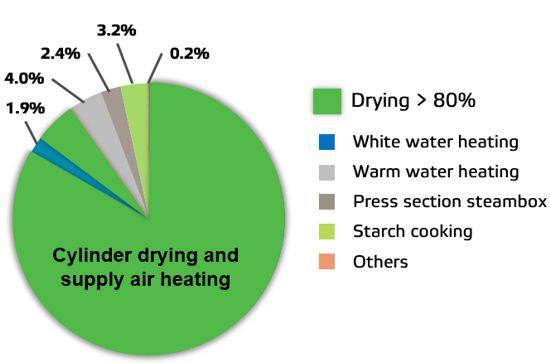
Cylinder drying and supply air heating account for 80% of thermal energy costs.
Drying is the most energy-intensive process in the papermaking process accounting for 80% of thermal energy costs due principally to cylinder drying and supply air heating. Drying energy consumption depends on many factors such as press design concept, steam and condensate system optimization, hood air balance and exhaust humidity control. This article looks at the latter two factors, namely the optimization of the paper machine hood and air systems.
[A free webinar for papermakers discussed this topic in depth on September 23rd, 2020. Click HERE to view the webinar.]
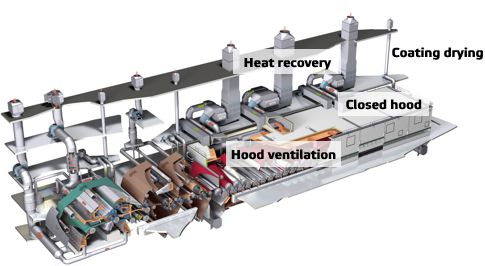
Air systems and energy efficiency - The most important systems are related to the drying process.
Just looking at the tons of steam consumed per ton of paper produced (tsteam/tproduction) doesn’t correctly rate the efficiency of the drying process. A more complete and realistic evaluation is the steam consumption per ton of water evaporated: tsteam/tevaporated H2O. For example, air balance of the papermachine hood has a significant impact on steam consumption at the drying cylinders, if we consider that all air flow through the dryer section is heated up to exhaust air temperature, including the cold, ambient leakage air that infiltrates into the hood; this air is also being heated by the dryer cylinders, in turn consuming steam. The graph below shows the impact of leakage air on dryer section ventilation and the related annual energy cost:
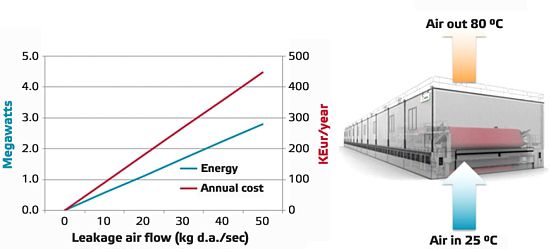
Leakage air flow, energy and cost
As a case example, let's consider a hood operation where all exhaust controls are 100% open. The evaporated water would then be exhausted from the dryer section with an average air humidity of 109 g H2O/kg d.a (or 0.1090 lb/lb = 763 grains) versus the original exhaust load for which the hood was designed, being 160 g H2O/kg d.a. (or 0.1600 lb/lb = 1120 grains).
As a result, to maintain this lower exhaust load there would be additional leakage air required of 57 kg d.a/s which in turn would also be heated by the dryer cylinders. The increase in steam consumption would be 2.8 MW or 4.9 t steam/h which would represent 7.3% of the drying section’s steam consumption.
There are also electrical savings possible by improving air balance. Small changes in air flow can result in important changes in required fan power. Since fan power is in relation to air flow (rotation speed) to the power of three, then as an example, a 10% reduction in air flow would save 27% in electrical cost.
Therefore, to maintain good energy efficiency the use of an air balance control is recommended with the following function:
- Set-point of the exhaust air humidity is calculated based on exhaust air temperature.
- Exhaust air humidity is measured and controlled by fan speed.
- Supply air flow (air balance) is adjusted based on air flow measurements.
- Zero-pressure level measurement is used for fine tuning of air balance.
- Supply air temperature is controlled by fresh steam coil.
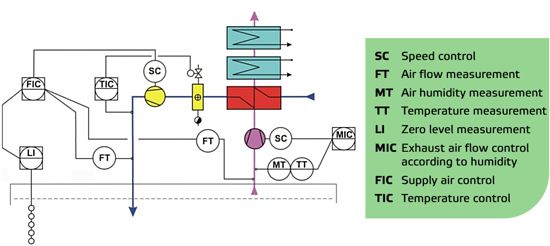
Valmet XT Control System process schematic
One such system is the XT Control by Valmet, an automated hood exhaust air humidity and hood air balance control system which monitors and optimizes the hood's zero-pressure line.
A principal control parameter of this system is the hood exhaust air humidity set point which varies according to hood exhaust air temperature as seen below:
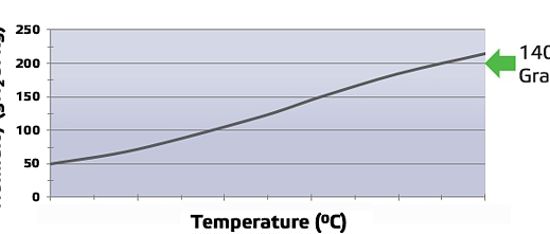
Exhaust air humidity as a function of temperature
The zero-level measurement is done with special sampling ports and temperature sensors.
A case example at Guangzhou PM9 in China combined this system with a full scope blow-box upgrade which had the goal of optimizing dryer section ventilation. The result was an energy savings of 500 kW in electricity. Hood air balance improved with a reduction in total hood exhaust volume and reduced spill into the machine room. An energy savings of 500 kW in electricity produced an annual savings of $200,000/yr for a return on investment period of 4 months.
In the reference period between 2010 and 2020, Valmet supplied 50 hood deliveries of which 45 had complete XT Control systems. In 2018 alone, 8 start-ups of OptiAir Hoods all had XT Control, not considering all the rebuilds which also included XT Control Systems.
For the savings to be sustainable, the flow meters and humidity sensors must be adequately maintained for proper calibration. A regular inspection strategy is required to upkeep the equipment, such as sending units back to the OEM for recalibration every 6 months. Without annual or semi-annual maintenance, it would be difficult to know how long such units could be accurate in measurement and automatic control. In the event of an instrument being off calibration, the system can be operated in remote manual control during the interim period while the recalibration work is conducted.
In summary, the factors affecting the energy savings in the dryer section are:
- Exhaust air humidity (hood exhaust air flow)
- Leakage air flow in to the hood (supply and exhaust air flow ratio)
- Tightness (sealing) and condition of the hood
- Functioning of the heat recovery
- Supply air temperature
- Pocket ventilation
In conclusion, these parameters can be addressed in a systematic way by breaking down the optimization work into the following 3 phases:
1) Know where you are:
- Quick Scans (snapshot of the process)
- Energy analyses
2) Optimize performance:
- Maintenance and repairs to obtain the best performance with the present equipment
- High sheet dryness after the press
- Hood construction and condition with energy efficient air balance
- Proper heat recovery, including water heating
3) Follow and monitor:
- Follow the right parameter for steam consumption, tsteam/tevaporated H2O
- Automatic air balance control (not measured = uncontrollable)
- Update machinery; upgrade equipment performance
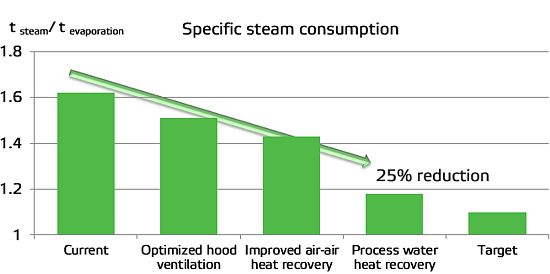
Optimizing specific steam consumption - stepwise action plan
To help facilitate the process, energy efficiency improvements can be done progressively to reduce your energy footprint step-by-step.
For more information on optimizing your air systems performance, watch the webinar and contact your Valmet representative.
